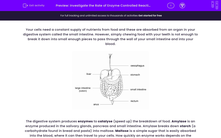Your cells need a constant supply of nutrients from food and these are absorbed from an organ in your digestive system called the small intestine. However, simply chewing food with your teeth is not enough to break it down into small enough pieces to pass through the wall of your small intestine and into your blood.
.jpg)
The digestive system produces enzymes to catalyse (speed up) the breakdown of food. Amylase is an enzyme produced in the salivary glands, pancreas and small intestine. Amylase breaks down starch (a carbohydrate found in bread and pasta) into maltose. Maltose is a simple sugar that is easily absorbed into the blood, where it can then travel to your cells. How quickly an enzyme works depends on the temperature and pH surrounding it.
In this worksheet, you will learn how to investigate the effect of pH on the rate of amylase activity. This is carried out in the lab (not in the digestive system) and a chemical called iodine is used to test a substance to see if it contains starch. If starch is present, iodine will change from brown/orange to black.

Method:
1. Add a few drops of iodine to each dimple of a spotting tile. Notice its brown-orange colour.
2. Heat a water bath to 35°C (this is close to human body temperature). A water bath is a container where the water is kept at a constant temperature. Most schools have an electronic water bath but if not, a beaker on a gauze, tripod, Bunsen burner and heat-proof mat can be used. Use a thermometer to check the temperature is remaining constant.
3. Add amylase solution and pH 8 buffer solution to a boiling tube using a syringe (a buffer solution is simply a solution used to maintain a constant pH). Leave in the water bath for roughly five minutes (this leaves enough time for the mixture to reach 35°C).
4. Now use a clean syringe to add starch solution to the same boiling tube, and mix the solutions together. Start a stopwatch straightaway and do not turn this off throughout the experiment.
5. Use a pipette to remove a sample of the amylase-starch-buffer solution in the boiling tube. Place this into the first dimple of the spotting tile. Repeat this every 30 seconds until the iodine remains brown-orange and no longer turns black. Once the iodine remains completely brown-orange, it means there is no starch left in the boiling tube. In other words, the amylase in the amylase-starch-buffer solution has catalysed the breakdown of all the starch into maltose. You may now (and only now) stop the stopwatch and record the time.
6. Repeat the experiment with a range of pH values (for example pH 4, 6 and 10). Use the results to work out the effect of pH on the time taken for starch to be broken down by amylase.
Control variables also need to be considered during this investigation. These are variables that need to be kept the same in order to make sure the test is fair and your results are as accurate as can be. Examples include using the same volume of amylase, the same concentration of amylase and the same volume of starch solution.
Now let's try some questions!



.PNG)
.PNG)
.PNG)




